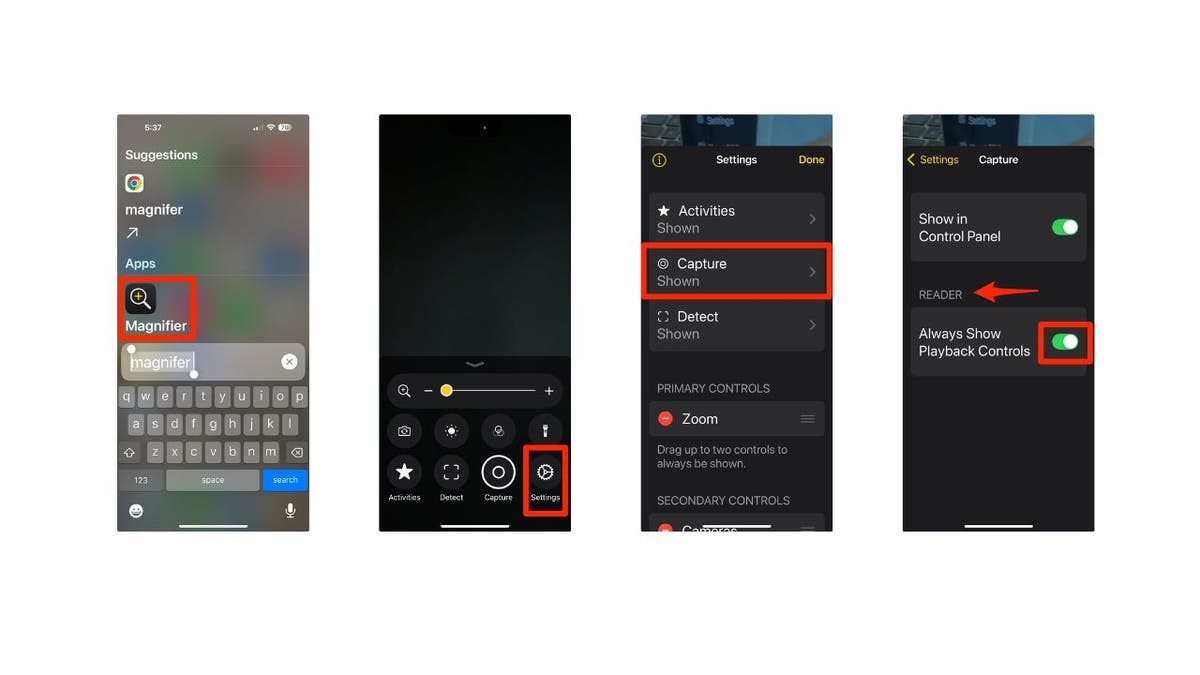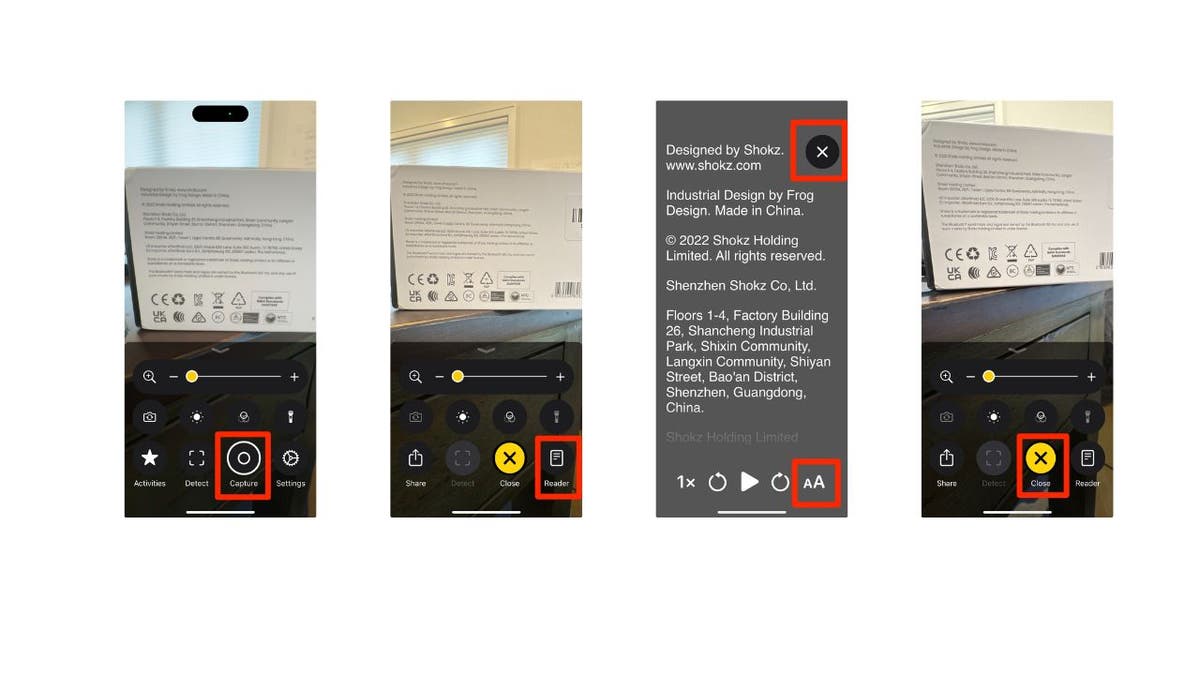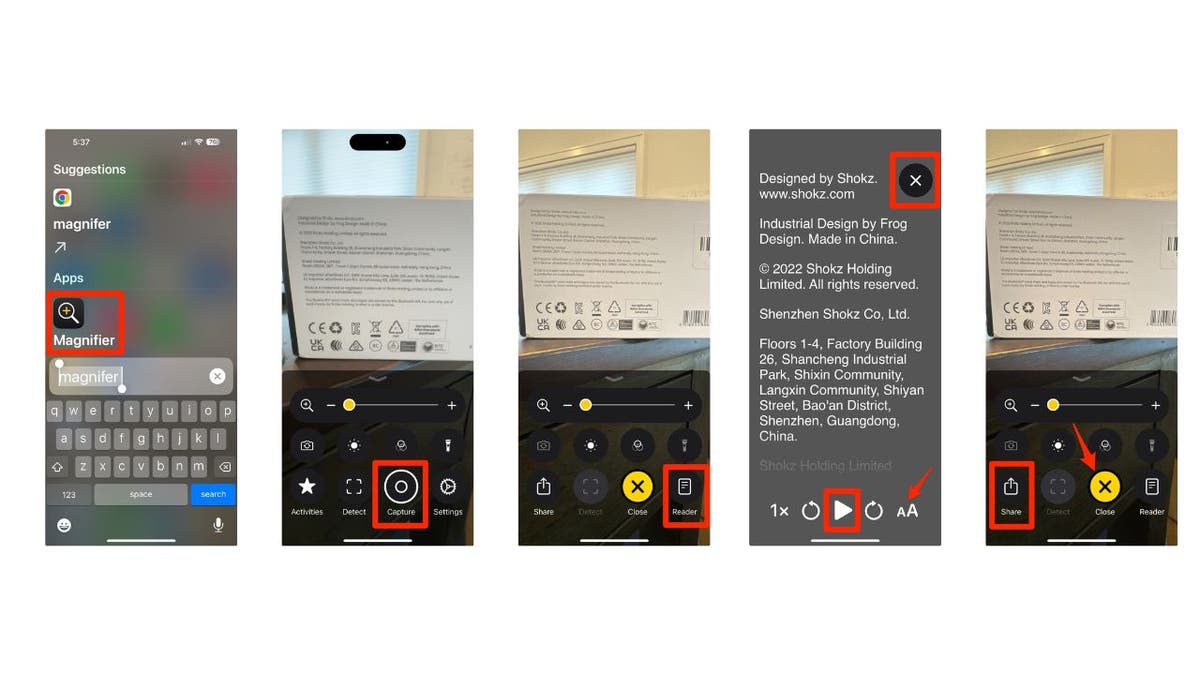Europe has an electric bike problem. Direct-to-consumer e-bikes from inexpensive Chinese brands like Engwe and countless others can be easily purchased online despite openly flouting EU restrictions. They feature throttles and powerful motors that can be easily unlocked to far exceed the 25km/h (16mph) legal speed limit — no pedaling required.
Technology
Let your iPhone read aloud what you can't see

Apple’s iOS 18 brings a host of new features aimed at enhancing your accessibility.
Among these, the upgraded Magnifier app stands out with its innovative Reader Mode, designed to assist you in reading small or dark text with ease.
A woman having trouble reading things (Kurt “CyberGuy” Knutsson)
Ensure you have iOS 18 installed
Before you can take advantage of the new features in the Magnifier app, make sure your device is running iOS 18. Follow these steps to check and update your iOS.
GET SECURITY ALERTS, EXPERT TIPS – SIGN UP FOR KURT’S NEWSLETTER – THE CYBERGUY REPORT HERE
Check your current iOS Version:
- Open the Settings app on your device
- Tap General
- Tap About, and you’ll see the version number next to Software Version.
Update to iOS 18:
- Go to Settings
- Tap General
- Tap Software Update
- If iOS 18 is available, tap Download and Install
- Follow the on-screen instructions to complete the update

Steps to update to iOS 18 on iPhone (Kurt “CyberGuy” Knutsson)
APPLE’S BOLD MOVE INTO AI: NEW IPHONE 16, AIRPODS AND WATCHES
The power of Magnifier’s Reader Mode
Have you ever struggled to read something small or in poor lighting? The new Reader Mode in iOS 18’s Magnifier app is here to help. By simply snapping a picture, this feature translates all the text in the image into a clear, easy-to-read page. Here are the steps to use Reader Mode.
- Launch the Magnifier app on your iOS device. You can do this by searching for it in the Spotlight search or accessing it via Control Center if you’ve added it there.
- Once inside the Magnifier app, tap on the Settings icon (or gear icon) in the top or bottom corner of the screen.
- In the settings menu, click Capture to enable Reader Mode by toggling the switch.
- Click the left-hand yellow arrow in the upper left of the screen to exit.
- Next, tap Done

Steps to use Magnifier Reader Mode (Kurt “CyberGuy” Knutsson)
CLICK HERE FOR MORE US NEWS
- Now, position your camera over the text you want to read and tap the Capture button to take a picture.
- After taking the picture, you’ll see an option to apply Reader Mode. Tap on the Reader Mode icon to convert the text into a clear, readable format.
- Customize your reading experience by adjusting font size, contrast and background color using the controls at the bottom of the screen. This helps improve readability, especially in low-light conditions or for small fonts.
- You can scroll up and down the screen to read the text.
- When you are done, just tap the X in the black circle in the upper right of the screen.
- Then tap the X in the yellow circle where it says close below it to completely exit.
HOW TO PROTECT YOUR IPHONE & IPAD FROM MALWARE

Steps to use Magnifier Reader Mode (Kurt “CyberGuy” Knutsson)
APPLE TRANSFORMS AIRPODS PRO 2 INTO LOW-COST HEARING AIDS
Text-to-speech functionality
In addition to visual adjustments, the Reader Mode also includes a text-to-speech option. This allows the app to read the text out loud, making it even more accessible for those with visual impairments or those who prefer auditory learning. Here’s how to use the Magnifier’s Reader Mode.
- Launch the Magnifier app on your iOS device. You can do this by searching for it in the Spotlight search or accessing it via Control Center if you’ve added it there.
- Now, position your camera over the text you want to read. Tap the Capture button to take a picture.
- After taking the picture, you’ll see an option to apply Reader Mode. Tap on the Reader Mode icon to convert the text into a clear, readable format.
- Customize your reading experience by adjusting font size, contrast and background color using the controls at the bottom of the screen. This helps improve readability, especially in low-light conditions or for small fonts.
- Then tap the Play button at the bottom of the screen to listen to the text.
- Tap the X at the top right of the screen to exit.
- If you want to keep the text for later or share it with someone, tap the Share icon to save or send the readable version of the text.
- When you want to exit, tap the yellow circle with the X in the center of it.

Steps to use text-to-speech functionality in Reader Mode (Kurt “CyberGuy” Knutsson)
SUBSCRIBE TO KURT’S YOUTUBE CHANNEL FOR QUICK VIDEO TIPS ON HOW TO WORK ALL OF YOUR TECH DEVICES
Kurt’s key takeaways
The new Reader Mode in iOS 18’s Magnifier app is a game-changer for accessibility. By offering customizable reading options and text-to-speech functionality, Apple continues to lead the way in making technology more inclusive for everyone. Whether you’re reading small print or navigating low-light conditions, the Magnifier app ensures that you can access the information you need with ease.
What other features would you like to see in future iOS updates to enhance your iPhone experience? Let us know by writing us at Cyberguy.com/Contact.
For more of my tech tips and security alerts, subscribe to my free CyberGuy Report Newsletter by heading to Cyberguy.com/Newsletter.
Ask Kurt a question or let us know what stories you’d like us to cover.
Follow Kurt on his social channels
Answers to the most asked CyberGuy questions:
New from Kurt:
Copyright 2024 CyberGuy.com. All rights reserved.

Technology
Engwe Mapfour N1 Pro e-bike review: the new ‘premium’

Here in Amsterdam, cheap Super73-knockoffs ridden at almost twice the legal speed have made the city’s renowned bicycle lanes increasingly chaotic and dangerous. Across the Netherlands, over 10,000 of these electric “fat bikes” were seized in 2024.
Engwe’s new Mapfour lineup is the company’s attempt at going legit by expanding from souped-up electric fat bikes and foldables into “premium commuter” e-bikes. And because they’re the first e-bikes that Engwe has designed exclusively for European roads, the company swears they can’t be unlocked for more speed.
I’ve been riding the new Mapfour N1 Pro model for the last few weeks. It lists for €1,899 (almost $2,000), or €1,799 during the initial launch — a price that brings heightened expectations.
The N1 Pro is slathered in premium capabilities like GPS/GSM tracking for which some bike makers charge subscriptions. The monocoque frame and fork are made from carbon fiber supplied by Toray — “the same high-quality carbon fiber as Trek and Specialized,” claims Engwe. There’s even turn-by-turn navigation built into the full-featured app, a large colorful display integrated into the handlebars, and a built-in mechanical lock in the rear wheel hub that automatically engages when the bike is turned off and stationary.
My review bike was missing a fender bolt, occasionally flashed a strange error code, and the solar-powered rear light won’t turn on. Still, it’s likely the highest quality electric bike Engwe has ever made.

$1714
The Good
- Looks and rides sporty
- Long list of features for price
- Removable battery
- Can’t be speed hacked
The Bad
- Strange error messages
- Servicing parts likely an issue
- Doesn’t support height range claimed
- Can’t be speed hacked
I have lots of experience with assembling direct-to-consumer e-bikes and the N1 Pro was ready to ride in about an hour, which is typical. Even with a carbon-fiber frame it weighs 20.1kg (44lbs) fully assembled according to my scale, which is heavy for an e-bike — just not Veloretti-heavy.

In the box you’ll find a basic toolset that includes everything needed for assembly and instructions written in stellar English unlike some previous Engwe tutorials I’ve read. I had to assemble the pedals, front wheel, kickstand, handlebar, and fenders, and fish out a replacement fender bolt from some spare bicycle parts I had lying around. I then went to adjust the saddle to my height only to discover that I was too tall for the N1 Pro.
The saddle stem has a marked safety line that stops well before the height needed for my 6 foot (183cm) frame, despite being sold in the Netherlands where I’m considered a short king. Nevertheless, exceeding the line by about 2.5cm (one inch) hasn’t made the saddle feel insecure, even when riding over rough cobblestones. Engwe claims the N1 Pro supports riders from 165–190cm, and is considering offering the option for a longer saddle stem at checkout based upon my feedback.
The N1 Pro’s geometry puts the rider into what’s essentially a mountain bike stance: a moderate forward lean with hands spread wide out in front of the body. That wrist and body angle combined with a rather stiff saddle are not ideal for riding long distances, especially in combination with a backpack that’ll put even more weight on the hands and derrière. I do like that fun, sporty posture over short distances, but if you’re looking for a more relaxed ride then Engwe has the upright €1,399 MapFour N1 Air available in both step-over and step-through frames.




The 250W mid-drive Ananda motor on the N1 Pro is nearly silent under the din of road noise, and the integrated torque sensor provides an intuitive pedal-assist at all speeds. It produces up to 80Nm of torque that lets me easily start from a dead stop in fourth gear (of seven) on flat roads, but testing on a hill with a gradient of about 15 percent required a start from first gear. Typically, I only needed to shift to a high gear when I wanted to use my leg power to propel the bike at speeds above the 25km/h motor cutoff.
Despite claiming a range of up to 100km from its modest 360Wh battery, my first test performed over a few weeks yielded just 23km off a full charge in near-freezing conditions. I usually rode in power setting three of five on mostly flat roads. The second test performed on a single warmer day improved the range to 27km with 28 percent charge remaining — or an estimated 36km if I had time to run the battery dry for a below average 10Wh consumed per kilometer travelled. The bike battery seems to suffer from idle battery drain of about 1-2 percent per day when parked inside my house.
Worrisome for a “premium” e-bike: on two occasions I saw an “09” error message flash on the display which Engwe is still diagnosing. Once, while starting the bike after it had been sitting outside in the rain for a few hours. Another time after riding home on a rain-soaked street while switching between the N1 Pro’s regular and high-beam lights. In the first case, a simple reboot cleared it and I was able to ride away fine, but the other time required riding home under my own power before it inexplicably cleared the next morning.
- The bike’s integrated display is readable in all lighting, and shows the remaining battery level, speed, power level, and even distance and direction of next turn if using the navigation built into the useful but overwrought Engwe app.
- I didn’t find Engwe’s turn-by-turn navigation very useful as the guidance presented on the display wasn’t informative or urgent enough for me to make confident decisions when traversing the dense network of crossroads in Amsterdam.
- It has a very loud alarm that can ward off thieves and help locate the e-bike in large parking garages.
- The daytime running lights are fun and help with visibility, but also dorky if you choose the animated options.
- The solar-powered rear light never worked on my review unit.
- Engwe provides a chain guard on shipping units.
- The hydraulic disc brakes from an unspecified vendor provide good controlled stops.
- Includes a 1-year warranty on electrical components, chassis, and battery.
1/19
There was a time when premium e-bikes had list prices around €2,000 / $2,000. Those days are as gone as the free venture capital propping up e-bike startups, pushing premium prices up to a starting price closer to €3,000 / $3,000. The Engwe N1 Pro is therefore priced about right. It’s not a bad e-bike, but it’s also not great despite checking off lots of features on a marketing sheet.
Just remember, servicing a direct-to-consumer e-bike can be a problem as it requires the ready availability of spare parts and the knowledge to replace them. As with any electric bike exposed to the elements and regular road use, the N1 Pro’s motor and any proprietary electronics like the controller, display, battery, lights, buttons, and integrated lock will eventually need servicing. So you’d better be on very good terms with your local bike shop or be handy with a wrench and oscilloscope to prevent your mail-order e-bike from quickly turning into e-waste.
Photography by Thomas Ricker / The Verge
Technology
Elon Musk’s SpaceX prepares for 8th Starship launch, pending FAA approval

Elon Musk’s SpaceX is preparing to launch the eighth flight test of Starship from Boca Chica, Texas, which could blast off as soon as this Friday as long as the Federal Aviation Administration (FAA) gives its approval.
“Starship Flight 8 flies Friday,” Musk, the CEO of SpaceX, said in a post on X Sunday.
For the first time, the upcoming flight has a planned payload deployment and multiple experiments on re-entry geared toward returning the upper stage booster to the launch site to be caught.
The launch will also include the return and catch of the Super Heavy booster that will blast the rocket off the launchpad.
STARSHIP UPPER STAGE LOST ON SEVENTH TEST FLIGHT, DEBRIS SEEN SPEWING IN SKY
Starship Flight 7 launches from Starbase, Texas, before its upper stage was lost. (Associated Press)
During the flight test, Starship will deploy four Starlink simulators, which are about the same size as next-generation Starlink satellites, SpaceX said.
The Starlink simulators will be deployed in the same sub orbit as Starship and are expected to burn up upon re-entry.
While Starship is in space, SpaceX also plans to relight a single Raptor engine.
POWERFUL WEBB TELESCOPE SPIES SPECTACULAR STAR BIRTH CLUSTER BEYOND THE MILKY WAY

Starship Flight 7 launches from Starbase, Texas. (Associated Press)
If all goes as planned, the launch window will open at 6:30 p.m. ET.
The launch comes more than a month after SpaceX launched Starship Flight 7 from the Starbase test site in Boca Chica, which resulted in Starship experiencing a “rapid unscheduled disassembly” nearly 12 minutes into the flight.
The Super Heavy booster descended back to Earth, where it maneuvered to the launch and catch tower arms at Starbase, resulting in the second ever successful catch of Super Heavy.
Starship, however, was not as successful.
MERGER OF MASSIVE BLACK HOLES FROM EARLY UNIVERSE UNCOVERED BY WEBB TELESCOPE, SCIENTISTS SAY
“Starship experienced a rapid unscheduled disassembly during its ascent burn,” SpaceX said in a statement Jan. 16. “Teams will continue to review data from today’s flight test to better understand root cause. With a test like this, success comes from what we learn, and today’s flight will help us improve Starship’s reliability.”
SpaceX has investigated what caused Starship to break apart, though the investigation remains open.
For Starship Flight 8 to blast off, the FAA must give its approval, which could come in a few ways.
In 2023, the FAA issued a five-year license to SpaceX for launches from Texas, which is revisited for every launch in case modifications need to be made for things like the trajectory of the rocket. The FAA could grant approval once mission specifics and license modifications are made, the FAA told Fox News Digital.
But also lingering is the open investigation into the Starship Flight 7 mishap. To fly again, the investigation needs to be closed, and the FAA must accept the findings. Specifically, the FAA weighs whether the incident put public safety at risk.
At the time of this writing, the investigation had not been closed, and the FAA had not given approval. Still, it is common for the approval to be issued a day or two before launch, the FAA noted.
SpaceX did not respond to Fox News Digital’s request for comment on the matter.
Fox News Digital’s Louis Casiano contributed to this report.
Technology
Longer-lasting laptops: the modular hardware you can upgrade and repair yourself

The goal, Patel says, is to continuously cycle through all of Framework’s actively supported laptops, updating each of them one at a time before looping back around and starting the process over again. Functionality-breaking problems and security fixes will take precedence, while additional features and user requests will be lower-priority.
-

 Technology1 week ago
Technology1 week agoVision Pro apps: the good, the bad, and the ridiculous
-

 News1 week ago
News1 week agoDominican officials cram thousands of inmates facing no charges into overcrowded prisons
-

 Politics1 week ago
Politics1 week agoTop federal agency exposed for spending billions on migrants in a single year
-

 Culture1 week ago
Culture1 week agoAre NFL players as college coaches here to stay? Why DeSean Jackson, Michael Vick can work
-

 News1 week ago
News1 week agoKamala Harris Has Scrambled the California Governor’s Race Without Entering It
-

 Culture1 week ago
Culture1 week agoBook Review: ‘Theory & Practice,’ by Michelle de Kretser
-

 Technology1 week ago
Technology1 week agoReddit vs. Wall Street: the latest in the GameStop saga
-

 Lifestyle1 week ago
Lifestyle1 week ago‘Modern Love’ Podcast: Why Gossiping Could Help Your Love Life

















